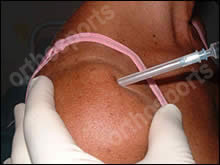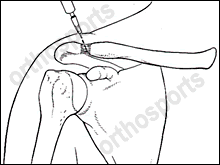Home > Teaching > Injection Techniques > Acromio-Clavicular Joint Injections
Acromio-Clavicular Joint Injections
The Acromio-Clavicular joint is often called the AC Joint (ACJ).
This is where the collarbone joins the shoulder and substantial forces are transmitted.
A fall on the outstretched hand, for example, may result in an injury to the ACJ, such as a sprain or possibility a fracture. With any significant injuries, Xrays (with weight-bearing films) are recommended. The important structure which allows the AC joint to remain stable is called the Coracoclavicular ligament. This can be stretched or completely torn during the injury.
ACJ pain may persist after a sprain or may occur as a result of repeated injuries such as with weight lifting (eg heavy bench press, shoulder press or ‘dips’).
If the coracoclavicular ligament is completely torn surgical reconstruction of the joint may be recommended. Usually non-operative treatment is recommended and corticosteroid (cortisone) injections into the joint are often helpful.
The ACJ may be approached anteriorly, posteriorly or superiorly. Anterior and superior approaches are most common.


Standard aseptic precautions must be used and a combination of 1 ml corticosteroid with 1 ml of local anaesthetic may be introduced.
